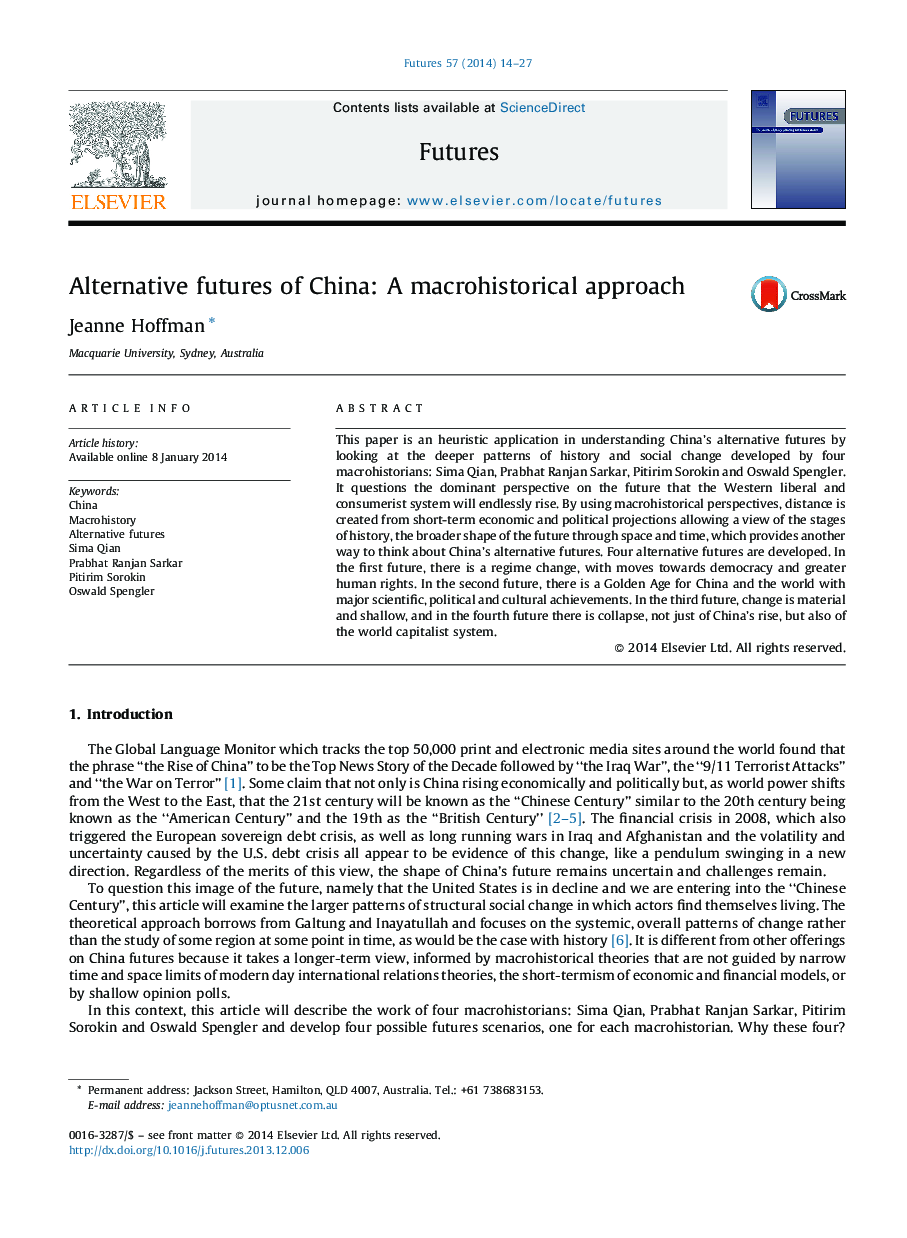| کد مقاله | کد نشریه | سال انتشار | مقاله انگلیسی | نسخه تمام متن |
|---|---|---|---|---|
| 7424532 | 1482772 | 2014 | 14 صفحه PDF | دانلود رایگان |
عنوان انگلیسی مقاله ISI
Alternative futures of China: A macrohistorical approach
ترجمه فارسی عنوان
آینده جایگزین چین: رویکرد ماوراء تاریخی
دانلود مقاله + سفارش ترجمه
دانلود مقاله ISI انگلیسی
رایگان برای ایرانیان
کلمات کلیدی
ترجمه چکیده
این مقاله یک کاربرد اکتشافی در درک آینده ی آینده جایگزین با نگاهی به الگوهای عمیق تر تاریخ و تغییرات اجتماعی است که توسط چهار شخصیت کلان، یعنی سیما قیان، پرهابات رنجان سرکار، پتییمر سوروکین و اسوالد اسپنگلر، ایجاد شده است. این سؤال چشم انداز غالب در مورد آینده است که نظام لیبرال غربی و مصرف کننده به طور بی نهایت افزایش خواهد یافت. با استفاده از دیدگاه های مکتب تاریخی، فاصله از طرح های اقتصادی و سیاسی کوتاه مدت ایجاد می شود که به دیدگاه مراحل تاریخ، شکل گسترده تر آینده از طریق فضا و زمان می انجامد، که راه دیگری برای فکر کردن در مورد آینده ی آینده چینی است. چهار آینده جایگزین توسعه یافته است. در آینده ی اول، تغییر رژیم با حرکت به سوی دموکراسی و حقوق بشر بیشتر خواهد شد. در آینده دوم، عصر طلایی برای چین و جهان با دستاوردهای علمی، سیاسی و فرهنگی وجود دارد. در آینده سوم، تغییر مادی و کم عمق است، و در آینده چهارم سقوط، نه تنها از افزایش چین، بلکه از نظام سرمایه داری جهانی است.
موضوعات مرتبط
علوم انسانی و اجتماعی
مدیریت، کسب و کار و حسابداری
کسب و کار و مدیریت بین المللی
چکیده انگلیسی
This paper is an heuristic application in understanding China's alternative futures by looking at the deeper patterns of history and social change developed by four macrohistorians: Sima Qian, Prabhat Ranjan Sarkar, Pitirim Sorokin and Oswald Spengler. It questions the dominant perspective on the future that the Western liberal and consumerist system will endlessly rise. By using macrohistorical perspectives, distance is created from short-term economic and political projections allowing a view of the stages of history, the broader shape of the future through space and time, which provides another way to think about China's alternative futures. Four alternative futures are developed. In the first future, there is a regime change, with moves towards democracy and greater human rights. In the second future, there is a Golden Age for China and the world with major scientific, political and cultural achievements. In the third future, change is material and shallow, and in the fourth future there is collapse, not just of China's rise, but also of the world capitalist system.
ناشر
Database: Elsevier - ScienceDirect (ساینس دایرکت)
Journal: Futures - Volume 57, March 2014, Pages 14-27
Journal: Futures - Volume 57, March 2014, Pages 14-27
نویسندگان
Jeanne Hoffman,
